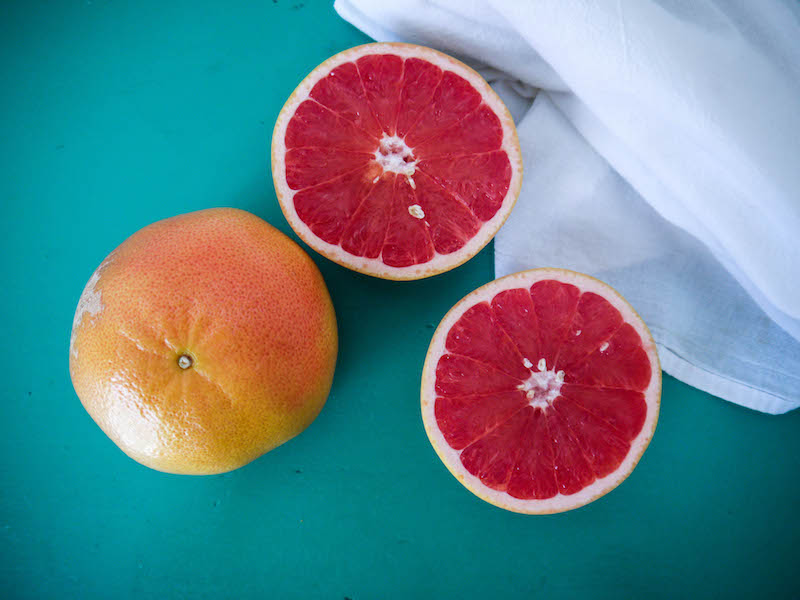Grapefruit (Citrus x paradisi): “The term Citrus derives from the Greek term for the citron, kedromelon. Paradisi means ‘coming from paradise.'”
This time of year, in the produce section of my local grocery store, there is a corner I turn, where the papery skins of onions and garlic and the piles of dusky, dusty potatoes give way to a gleaming corridor of citrus. On each side of the aisle are overflowing piles of lemons and limes, mandarins, tangerines, oranges sliced in half to reveal deeply crimson flesh of Blood Orange or the pale pink of a Cara Cara. There are Satsumas and Variegated Pink Lemons, the smooth, thin-skinned Meyer lemon, hefty Pummelos and gnarled twists of Buddha’s Hands. The stalls practically pulse with the vibrancy of hue. It’s like walking out of the chill of a winter’s day into the glow of a fire-lit room. Because I am in Texas, where the Ruby Red grapefruit is the state fruit, these displays take a proud center stage, and I join the flock of customers around the altar. The Ruby Red is plump, dense and blushing, the unexpected weight of one in my palm gently bending my wrist towards the floor. I can’t resist gently pushing my thumb nail into the thick skin, a spray of fragrant oil misting from its pores. What a clever design of nature, to deliver to us, in the coldest, darkest months, a fruit so bright, so pungent and electric that it sears through anything stagnant. It’s a lightning bolt in the dark. It’s a little orb of sunlight.
Grapefruits really do cut through stagnation in the body. As Dianne Onstad chronicles in her book Whole Foods Companion, the grapefruit aids in dissolving “inorganic calcium that may have formed deposits in the joints (as in arthritis) as a result of excessive consumption of devitalized white flour and pasteurized milk products.” She goes on, “A compound called galacturonic acid, found only in grapefruit, adds a unique therapeutic benefit: it breaks up and dislodges the fatty plaque buildup in arteries and whisks it away.” Its powers don’t end there. Grapefruit also helps flush old red blood cells from the body, aids in digestion, can stimulate appetite, and the extract from its seed is one of the strongest anti-bacterial and anti-fungals found in the plant world.
I love a grapefruit peeled and eaten in segments like an orange, or scooped section by section with the sharklike teeth of a grapefruit spoon, the remaining juice squeezed into the bottom of a bowl and tipped into my open mouth. The other morning, just for a change, I brushed my halved grapefruit with olive oil, sprinkled it with Maldon salt and fresh thyme, and broiled it. The slight caramelizing of the natural sugars softened the bitter backbone of the fruit, and the thyme-flecked juice squeezed out at the end was still warm, herbacious and very slightly salty. Coming from paradise indeed.
Broiled Grapefruit with Salt & Thyme
serves 4
2 Ruby Red grapefruits
1 t fresh thyme leaves, crushed, plus more to garnish
Good flaky sea salt
1 T extra virgin olive oil
-Preheat the broiler on high and line a cookie sheet with aluminum foil for easy clean up.
-Slice the grapefruits in half around the equator. If you don’t have grapefruit spoons, using a sharp paring knife, cut the flesh away from the skin at at the perimeter of each half and then cut the flesh away from the pith of in each triangular section of fruit. Careful not to cut all the way through the skin–you want to keep the juice contained in the skin for later consumption.
-Brush the top of each half with olive oil, sprinkle generously with sea salt and crushed thyme. Place flesh side up on the cookie sheet and broil until skin is lightly browned and the fruit is pushing away from the skin, about 10-15 minutes.
-Serve in bowls with sprigs of fresh thyme to garnish. Spoon, juice, slurp, enjoy.




 Subscribe via RSS
Subscribe via RSS